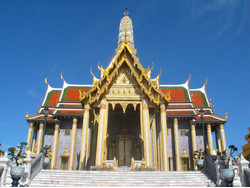Artwork Search
Arts in Southeast Asia Database
Prasat Phra Thep Bidorn
Keywords :
| Artwork alternative name | Phra Phuttha Prang Prasat |
|---|---|
| Site common name | Wat Phra Sri Rattanasatsadaram |
| Site alternative name | Wat Phra Kaew |
| Type of artwork | Architecture |
| Sub district | Phra Borom Maha Ratchawang |
| District | Khet Phra Nakhon |
| Province | Bangkok |
| Region | Central |
| Country | Thailand |
| Geographic Coordinates Decimal degree | Lat : 13.751633 Long : 100.492765 |
| Geographic Coordinates UTM | Zone : 47 P Hemisphere : N E : 661392.84 N : 1520758.33 |
| Place of artwork | On the eastern platform of Wat Phra Sri Rattanasatsadaram. |
| History of production | The construction started in 1855 AD in the reign of King Rama IV and finished in the reign of King Rama V. However, an electrical short caused a fire at the roof frame in the late reign. The restoration would be completed in the reign of King Rama VI. |
|---|---|
| Size | 40 m in height |
| Art | Prasat Phra Thep Bidorn is a four-portico building with Prang top. The front projecting portico is in the east. The wall is decorated by tiles in Phoom Khao Bindh pattern on blue background. The cornice is decorated with Chorfah, Bairaka, Naksadung and Hanghong. A prang is on the top of the building, which is made from plaster and decorated with coloured tiles. Its four pediments display the royal coats of arms. The northern portico’s pediment displays Unalom of King Rama I. The southern portico’s pediment displays Garuda holding Nagas of King Rama II. The western portico’s pediment displays Phra Viman of King Rama III and the eastern portico’s pediment displays Phra Makamongkut of King Rama IV. The windows and doorways has Mongkut tops which are coated with gold lacquer and glass, while the sided walls show the royal coats of arms of King Rama I – V. |
| Key academic information | King Rama IV ordered to build a prasat with Prang top called Phra Phuttha Prang Prasat to be a home of the emerald buddha on the platform near Phra Mondop. He thought by lowering the bussabok, people could see the buddha image more clearly. However, when the construction was completed in the latter reign, it was not used for the original purpose because of its narrow space did not suit for performing any rituals. Therefore, King Rama VI ordered to move his predecessor statues from Shivalayamahaprasat Throne Hall to stand inside this building and named after the group of statues as Prasat Phra Thep Bidorn. Normal people are allowed to pay obeisance to those statues, which are King Rama I – VIII, on the auspecious occasion, for instance, Chakri Memorial Day, King Chulalongkorn Day and Songkran Day. |
| Art period | Rattanakosin |
| Age | 19th century AD |
| Religion | Buddhism |
| Sect | Theravada |
| Religion and belief | Theravada Buddhism |
| Type of License | Attribution-NonCommercial-NoDerivs (CC BY-NC-ND) |
|---|---|
| Rights | Princess Maha Chakri Sirindhorn Anthropology Centre |
| Date of record creation | 2016-05-26 |
| Record creator | Patsaweesiri Premkulanan |
| Bibliography | ศิลปากร, กรม. จดหมายเหตุการบูรณะปฏิสังขรณ์วัดพระศรีรัตนศาสดารามและพระบรมมหาราชวังในการฉลองพระนครครบ 200 ปี พุทธศักราช 2525. กรุงเทพฯ : กรมศิลปากร, 2525. แน่งน้อย ศักดิ์ศรี, ม.ร.ว. พระบรมมหาราชวังและวัดพระศรีรัตนศาสดาราม. กรุงเทพฯ: ริเวอร์บุ๊คส์, 2543. |


